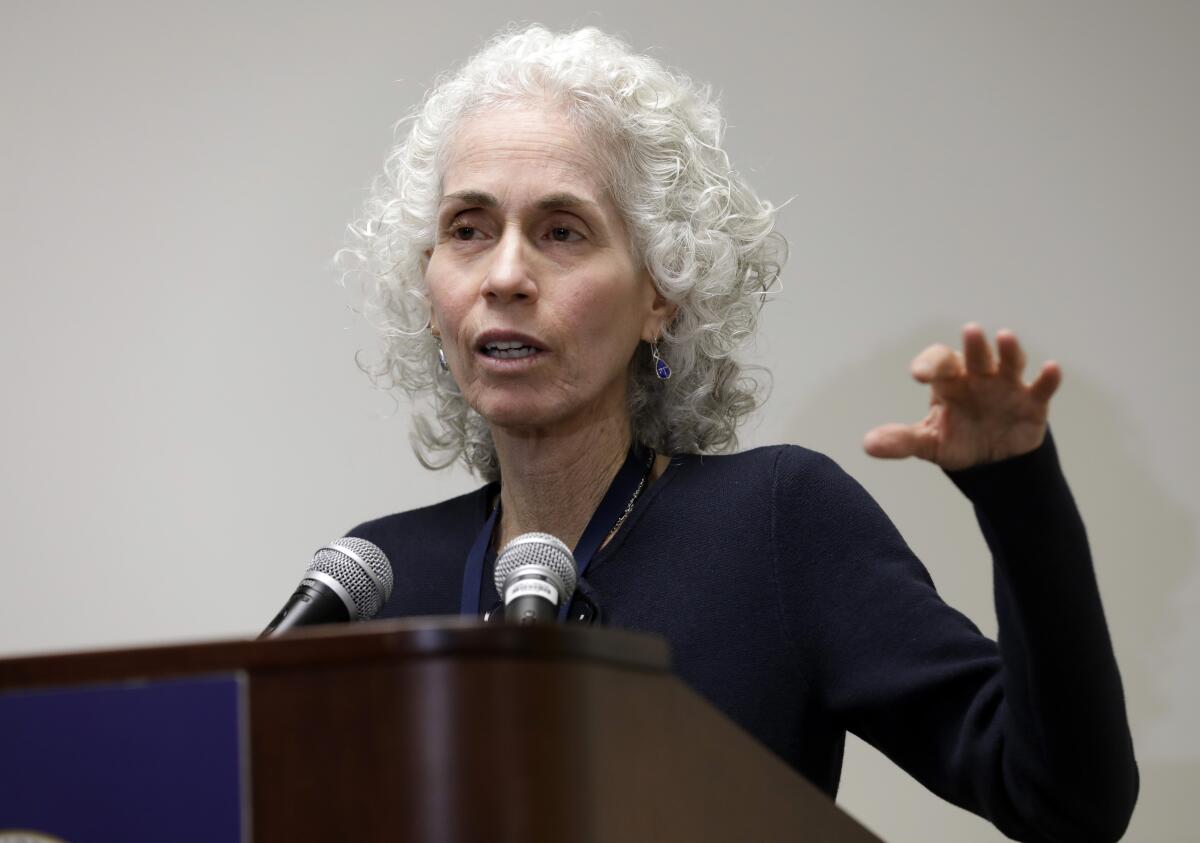Hospitals that pursue patients for unpaid bills will have to tell L.A. County

- Share via
Hospitals must promptly report to the Los Angeles County Department of Public Health every time they try to collect medical debt from patients, under an ordinance backed Tuesday by county supervisors.
The ordinance, which requires a second vote to be adopted, requires hospitals to tell the county within a month or two of initiating debt collection, which can include making phone calls or mailing letters to seek payment more than 180 days after the initial billing, selling the debt to a collections agency, garnishing wages, seizing a bank account or informing a consumer reporting agency.
The new rules would also require hospitals to report up to four times annually on the medical debt amassed in recent months by their patients and what financial assistance they have offered them. If they fail to do so, they could face fines and legal action.
Public health officials said the rules would help shed light on hospital practices and address a crucial question: Where are the missed opportunities for hospitals to provide financial assistance?
Hospitals are supposed to provide financial aid to patients in need, but “the rub is the implementation,” said Dr. Anish Mahajan, chief deputy director of the L.A. County Department of Public Health. In a survey by the national nonprofit Dollar For, less than 30% of patients saddled with hospital bills they couldn’t afford said they had applied for and ultimately received financial assistance.
Many hospitals make good efforts to offer aid, Mahajan said, but data show “there is just so much medical debt — and that debt is disproportionately carried by poor people.”
Los Angeles County officials estimate that medical debt totaled more than $2.9 billion in the county in 2022, burdening 1 in 10 adults.
The public health department has launched an initiative to quash medical debt, including buying up and forgiving existing debt. In June, it set aside $5 million for a planned agreement with a nonprofit that erases such debts, which county officials estimated could eliminate $500 million of debt for 150,000 residents.
But the county has stressed that it also wants to prevent patients from incurring medical debt in the first place. Mahajan said that by pulling together information under the new ordinance, “we can then understand how hospitals are doing ... in having their patients who should get financial assistance actually receive it.”
For instance, the county said it could match up data about patients whose medical bills were sent to collections to see if they might have been eligible for assistance, then reach out to hospitals about their findings.
“The goal is to help hospitals do better,” Mahajan said.
The figures could also help shed light on whether financial assistance is failing to reach particular groups of L.A. County residents, which could help guide future outreach and public education about the aid.
For instance, Mahajan suggested that in some cases, hospitals might have good policies on financial assistance, but some patients may fear seeking such aid amid worries about their immigration status.
Tackling such concerns could involve not just hospitals but other members of the county coalition that has sought to address medical debt, including legal aid and consumer groups, he said.
The mandatory reports could also give health facilities a sense of whether their financial assistance and debt collection practices fall outside the norm, compared with other hospitals in the area. Public health officials reported that hospitals across L.A. County provided more than $600 million in financial assistance in 2021, but more than half of it was from just four facilities — those run by the county itself.
Those safety net hospitals “can’t cover the entire county, and they’re doing the bulk of the financial assistance,” said Dr. Naman Shah, director of the division of medical and dental affairs at L.A. County Public Health. “The reason for this ordinance is that we can do better.”
Dr. Elaine Batchlor, chief executive of MLK Community Healthcare, told the county board that her Willowbrook hospital proactively takes steps to assess whether patients need aid, using software and other tools to check whether they are likely able to afford copays, then writing off the debt if their finances appear shaky.
Such financial tools “are widely available, and they’re not difficult to use,” Batchlor said Tuesday.
L.A. County will also put up a website where the public can peruse aggregate data about medical debt at local hospitals, although it is still determining exactly what information will be posted, Mahajan said.
The Hospital Assn. of Southern California said its members are deeply concerned about medical debt as an issue, but that the organization remains worried about some aspects of the county requirements.
In reaction to hospital concerns, the county has eased some rules surrounding how often reports must be provided, but “there still remain concerns about how voluminous” the data requirements will ultimately be, said Adena Tessler, the hospital association’s regional vice president for Los Angeles County.
For example, Tessler said that in some cases, hospitals might not be able to provide information because it hasn’t been provided by patients themselves. In addition, “the focus on hospitals remains a concern, because it’s just a piece of the medical debt issue.”
Public Health Director Barbara Ferrer said Tuesday that hospitals are a reasonable place to focus initially because “hospital bills comprise the majority of the debt and the largest bills.” Supervisor Janice Hahn added that “the work won’t stop here today” and that the county will be exploring how other entities — including insurance companies and private provider groups — play a role.
“Hospitals are not the sole cause of medical debt,” she said, “but starting there will help us develop a plan.”
Stanford University professor of economics Neale Mahoney applauded the effort, saying he hoped it would expand to other jurisdictions. “Medical debt is a dark corner in the U.S. healthcare system,” he said, and shining a light on it can be “a strong disinfectant.”
The L.A. County requirements would apply only to a small number of hospitals in unincorporated areas — county officials estimated the number at seven, including MLK Community Hospital — but local cities could adopt them to cover their jurisdictions as well. Hospitals will have roughly six months after the L.A. County ordinance goes into effect before failing to turn in the reports becomes a violation.
Tessler, of the hospital association, said that because the rules will be rolled out first in the unincorporated areas, her hope is that government officials will take the time to make sure that the reporting requirements make sense before expanding such rules to other parts of L.A. County.
Ferrer said her department would reassess the burdens of collecting such data in a year. In light of concerns about patient information, she said the portal that hospitals will use to provide information when they try to collect debt from individual patients is compliant with federal law on protecting patient privacy.
Batchlor, in her remarks Tuesday, described helping an uninsured friend diagnosed with cancer get the care she needed, only to recently learn that the woman was again uninsured because “she can now afford to either pay down her medical debt or pay the premiums for her health insurance — she can’t afford to do both.”
The hospital executive said that the “root cause of medical debt is the high cost of healthcare and the failure of health insurance to cover those costs.”
To solve the problem, she said, “we will ultimately need to address these root causes.”
More to Read
Sign up for Essential California
The most important California stories and recommendations in your inbox every morning.
You may occasionally receive promotional content from the Los Angeles Times.











